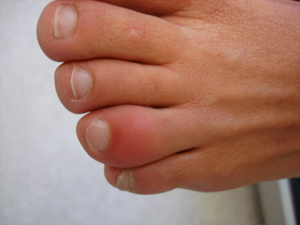"I was told that there is nothing you can do for a broken toe so I did nothing for it". Wrong!! So why is my toe still terribly swollen and painful two years later? These are common complaints from patients who have experienced firsthand the extreme pain from an injured small or lesser toe.
This often results in the development of the dreaded "sausage" toe that stays swollen for months, years, even a lifetime. You can imagine what it does to a person's fashion choices. The perpetually swollen toe is often uncomfortable in dress shoes, Manolos, Jimmy Choos, walking shoes and athletic sneakers. 
There is an increasing problem out there when people fracture a small toe either by hitting on the edge of a piece of furniture in the middle of the night, en route to the bathroom (called by some a "piss" fracture) or dropping the occasional bottle of wine on the foot from a small height. Other scenarios , alla Lost in Translation, is the suitcase little toe fracture sustained in a dark and unfamiliar hotel room, or the racing for the telephone or doorbell stub on the door plate.
Lesser or small toe pain does not translate into lesser pain and disability. A colleague of mine at Yale once told me that the velocity of a toe hitting a stationary piece of furniture or the bed post is between 60-80 mph. That says it all about the so called simple toe injury.
These fractures are unbelievably painful and unlike other fractures the pain can often last for months and cause disability and aches elsewhere such as the knee, hip, and back because of altered gait to avoid the pain of the injured lesser toe hitting the ground.
Patients also relate that they and their coworkers find it hard to believe that a little fractured toe can cause all this discomfort and chaos.
So why are so many people reluctant to treat a lesser toe fracture as they would any other fracture in the foot or elsewhere? 
It is first and foremost important to get a foot x-ray to check for the extent, severity, and location of the lesser toe fracture. Check to see if the fracture is straight thru the bone or slanted. Some fractures are more stable than others. It is also adviseable to perform an ultrasound examination of the forefoot to check for soft tissue, tendon, and ligament injury. Often the toe will separate from the other toes usually indicating an injury of this type.
The foot and toe should be immobilized with either a short removeable walking cast or a stiff soled surgical shoe depending on the location and severity of the lesser toe fracture, swelling, and if course pain. This may be worn up to 3-4 weeks depending on improvement of the symptoms. Most patients note a considerable decrease of pain, discomfort, and disability when they immobilize the foot with one of these devices. Flip flop type soft shoes would seem to make the toe feel better but are not advised and can make the pain and swelling worst.
In addition, buddy splinting the injured toe to the adjacent toe will provide additional immobilization and stability. Ice applied to the injured toe is also a good idea and is recommended to reduce the swelling in the injured toe and immediate surrounding areas.
Patients who do nothing are usually miserable, in pain and limping. They are at greater risk for developing the sausage toe.
Furthermore, not treating the lesser toe fracture can often lead to traumatic arthritis later on. Considering that the average person may take 10-20 thousand steps a day this is quite a workout for the little toe and clearly increases the likelihood for future pain, discomfort, and swelling.
So the best advice is to not ignore a lesser toe injury. Go to a foot specialist or trauma specialist to have the injury evaluated and treated aggressively. The longer you wait to treat and immobilize the toe and foot the greater the likelihood of developing a permanent swelling of the toe. Get in to see the doctor to avoid the sausage toe problem and remember there is a lot you should do when you injure your small toes.